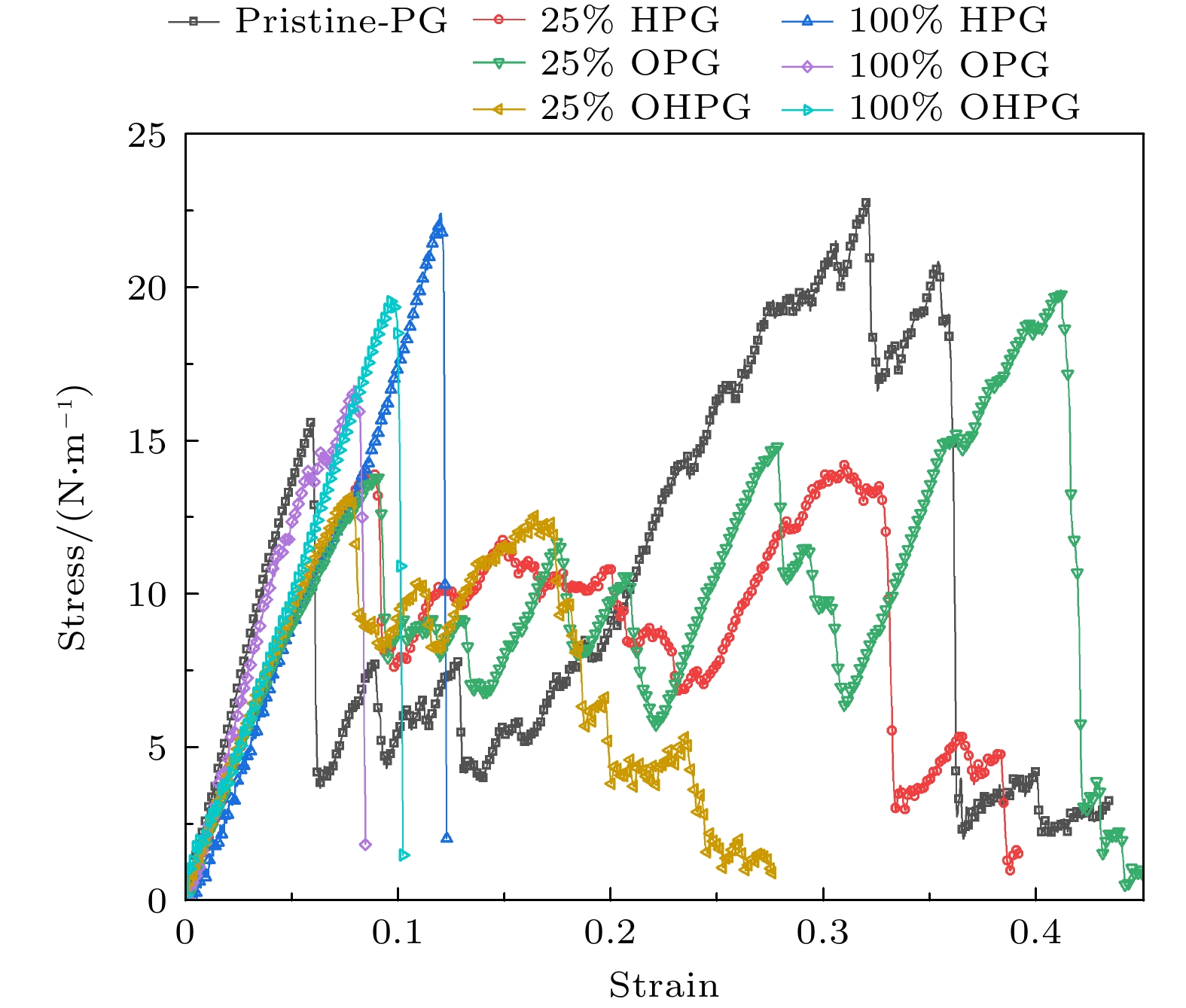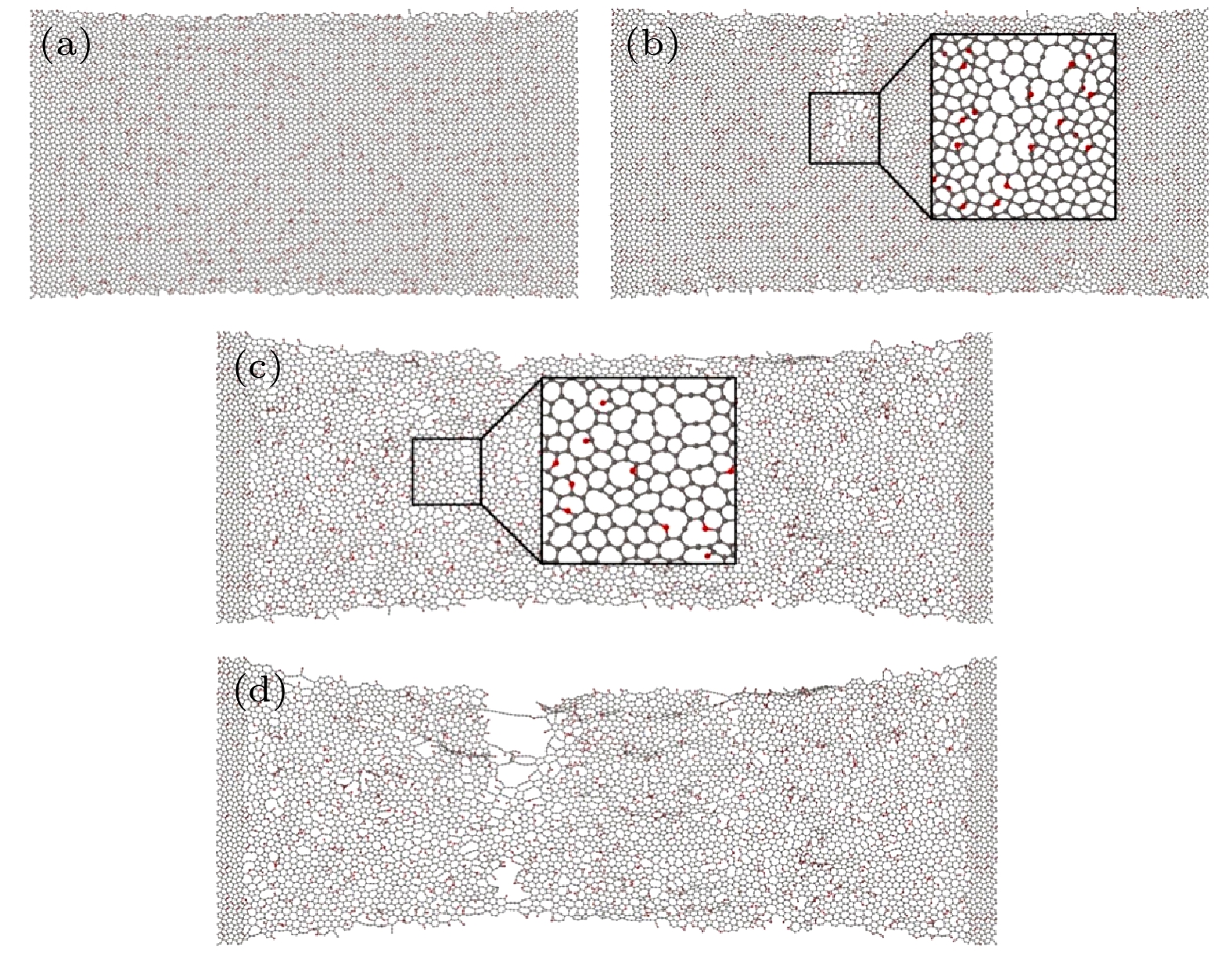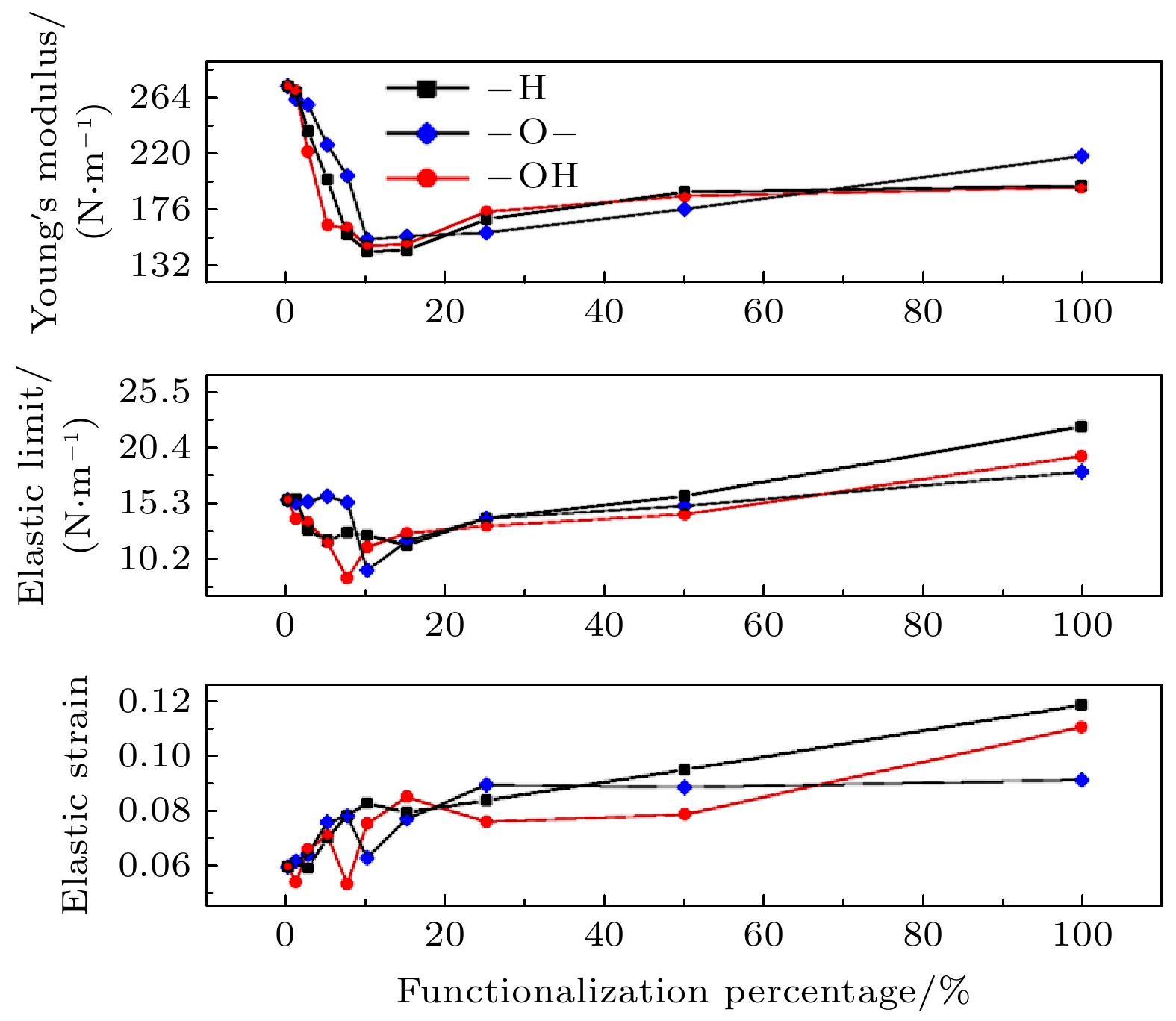-
五边形石墨烯是近年来提出的一种完全由碳五元环组成的新型二维纳米材料. 本文采用分子动力学方法研究了氢基、环氧基和羟基等官能团表面修饰及官能化率对五边形石墨烯力学性能和变形破坏机制的影响以及官能化对升温时五边形石墨烯结构转变的影响规律. 研究发现, 分别引入3种官能基团均可以有效地调控五边形石墨烯的力学性能和变形破坏机制. 五边形石墨烯的杨氏模量和弹性极限均随官能化率的增大先剧烈减小再缓慢增大, 而极限弹性应变单调递增. 低官能化率五边形石墨烯在拉伸载荷下仍然表现出类似于完美五边形石墨烯的塑性变形破坏特征, 不受约束升温时出现碳环结构转变, 临界转变温度高于五边形石墨烯, 而完全官能化可使五边形石墨烯由塑性向脆性变形破坏机制的转变, 升温时五边形石墨烯并未出现碳环结构的转变. 研究结果可为有效调控五边形石墨烯等二维纳米尺度材料的力学性能提供理论基础和结构设计依据.Penta-graphene is a new two-dimensional metastable carbon allotrope composed entirely of carbon pentagons with unique electronic and mechanical properties. In this work, molecular dynamics simulations are carried out to investigate the effects of functionalization by hydrogen, epoxide or hydroxyl groups on the mechanical properties and failure mechanism of penta-graphene, as well as the effects of different functionalization coverages. The effects of functionalization on the structural transformation of free-standing penta-graphene triggered by increasing temperature have also been studied. The results indicate that each of the three functional groups considered can effectively tune the mechanical properties and the failure mechanism of penta-graphene. Both the Young's modulus and elastic limit of penta-graphene first decrease sharply and then increase slowly with the increase of the functionalization coverage, while the ultimate elastic strain increases monotonically. Like the pristine penta-graphene, partially functionalized penta-graphene still exhibits a plastic deformation failure behaviour under tensile load, which is caused by the irreversible pentagon-to-polygon structural transformation occurring during tensile loading. Temperature can trigger structural reconstruction for free-standing partially functionalized penta-graphene, and the corresponding critical transition temperature is higher than that of pristine penta-graphene. However, complete functionalization can change the deformation mechanism of penta-graphene from plastic deformation to brittle fracture. For fully functionalized penta-graphene by each of the three functional groups, the structural transformation is not observed when tensile strain is applied or environmental temperature is increased. These findings are expected to provide important guidelines for effectively tuning the mechanical properties of two-dimensional nanomaterials including penta-graphene.
-
Keywords:
- penta-graphene /
- mechanical properties /
- functionalization /
- molecular dynamics
[1] Zhang S H, Zhou J, Wang Q, Chen X S, Kawazoe Y, Jena P 2015 Proc. Natl. Acad. Sci. U. S. A. 112 2372
 Google Scholar
Google Scholar
[2] Yu Z G, Zhang Y W 2015 J. Appl. Phys. 118 165706
 Google Scholar
Google Scholar
[3] Xu W, Zhang G, Li B W 2015 J. Chem. Phys. 143 154703
 Google Scholar
Google Scholar
[4] Carr L D, Lusk M T 2010 Nat. Nanotechnol. 5 316
 Google Scholar
Google Scholar
[5] Guo B D, Liu Q A, Chen E D, Zhu H W, Fang L A, Gong J R 2010 Nano Lett. 10 4975
 Google Scholar
Google Scholar
[6] Lahiri J, Lin Y, Bozkurt P, Oleynik I I, Batzill M 2010 Nat. Nanotechnol. 5 326
 Google Scholar
Google Scholar
[7] Han T W, Luo Y, Wang C Y 2015 Acta Mech. Solida Sin. 28 618
 Google Scholar
Google Scholar
[8] Berdiyorov G R, Dixit G, Madjet M E 2016 J. Phys.: Condens. Matter 28 475001
 Google Scholar
Google Scholar
[9] Li X Y, Zhang S H, Wang F Q, Guo Y G, Liu J, Wang Q 2016 Phys. Chem. Chem. Phys. 18 14191
 Google Scholar
Google Scholar
[10] Zhang Y Y, Pei Q X, Cheng Y, Zhang Y W, Zhang X L 2017 Comput. Mater. Sci. 137 195
 Google Scholar
Google Scholar
[11] Wu X F, Varshney V, Lee J, Zhang T, Wohlwend J L, Roy A K, Luo T F 2016 Nano Lett. 16 3925
 Google Scholar
Google Scholar
[12] Zhang Y Y, Pei Q X, Sha Z D, Zhang Y W, Gao H J 2017 Nano Res. 10 3865
 Google Scholar
Google Scholar
[13] Liu L Z, Zhang J F, Zhao J J, Liu F 2012 Nanoscale 4 5910
 Google Scholar
Google Scholar
[14] Suk J W, Piner R D, An J, Ruoff R S 2010 ACS Nano 4 6557
 Google Scholar
Google Scholar
[15] Pei Q X, Zhang Y W, Shenoy V B 2010 Carbon 48 898
 Google Scholar
Google Scholar
[16] Winczewski S, Shaheen M Y, Rybicki J 2018 Carbon 126 165
 Google Scholar
Google Scholar
[17] Erhart P, Albe K 2005 Phys. Rev. B 71 035211
 Google Scholar
Google Scholar
[18] Rahaman O, Mortazavi B, Dianat A, Cuniberti G, Rabczuk T 2017 FlatChem 1 65
 Google Scholar
Google Scholar
[19] Han T W, Cao S M, Wang X Y, Xuezi Y Y, Zhang X Y 2019 Mater. Res. Express 6 085612
 Google Scholar
Google Scholar
[20] Cranford S W 2016 Carbon 96 421
 Google Scholar
Google Scholar
[21] Han T W, Wang X Y, Zhang X Y, Scarpa F, Tang C 2021 Nanotechnology 32 275706
 Google Scholar
Google Scholar
[22] van Duin A C T, Dasgupta S, Lorant F, Goddard W A 2001 J. Phys. Chem. A 105 9396
 Google Scholar
Google Scholar
[23] Chenoweth K, van Duin A C T, Goddard W A 2008 J. Phys. Chem. A 112 1040
 Google Scholar
Google Scholar
[24] Le M Q 2017 Comput. Mater. Sci. 136 181
 Google Scholar
Google Scholar
[25] Chen M, Zhan H, Zhu Y, Wu H, Gu Y 2017 J. Phys. Chem. C 121 9642
 Google Scholar
Google Scholar
[26] Yoon K, Ostadhossein A, van Duin A C T 2016 Carbon 99 58
 Google Scholar
Google Scholar
[27] Hoover W G 1985 Phys. Rev. A 31 1695
 Google Scholar
Google Scholar
[28] Nose S 1984 Mol. Phys. 52 255
 Google Scholar
Google Scholar
[29] Swope W C, ersen H C, Berens P H, Wilson K R 1982 J. Chem. Phys. 76 637
 Google Scholar
Google Scholar
[30] Subramaniyan A K, Sun C T 2008 Int. J. Solids Struct. 45 4340
 Google Scholar
Google Scholar
[31] Zhao Y P 2014 Nano, Mesoscopic Mechanics (Beijing: Science Press) p 14
[32] Yagmurcukardes M, Sahin H, Kang J, Torun E, Peeters F M, Senger R T 2015 J. Appl. Phys. 118 104303
 Google Scholar
Google Scholar
[33] Los J H, Zakharchenko K V, Katsnelson M I, Fasolino A 2015 Phys. Rev. B 91 045415
 Google Scholar
Google Scholar
-
图 1 五边形石墨烯及其官能化几何模型示意图 (a) 五边形石墨烯薄膜的拉伸模型; (b) 完美五边形石墨烯的2×2超晶胞; (c)完全氢化五边形石墨烯的2×2超晶胞; (d)完全环氧基化五边形石墨烯的2×2超晶胞; (e)完全羟基化五边形石墨烯的2×2超晶胞
Fig. 1. Schematics of simulation models and atomic structures for pristine and functionalized penta-graphene. Side view and top view of (a) tensile model of pristine penta-graphene sheet, 2×2 supercell of (b) pristine penta-graphene, (c) fully hydrogenated penta-graphene, (d) fully epoxylated penta-graphene, (f) fully hydroxylated graphene.
-
[1] Zhang S H, Zhou J, Wang Q, Chen X S, Kawazoe Y, Jena P 2015 Proc. Natl. Acad. Sci. U. S. A. 112 2372
 Google Scholar
Google Scholar
[2] Yu Z G, Zhang Y W 2015 J. Appl. Phys. 118 165706
 Google Scholar
Google Scholar
[3] Xu W, Zhang G, Li B W 2015 J. Chem. Phys. 143 154703
 Google Scholar
Google Scholar
[4] Carr L D, Lusk M T 2010 Nat. Nanotechnol. 5 316
 Google Scholar
Google Scholar
[5] Guo B D, Liu Q A, Chen E D, Zhu H W, Fang L A, Gong J R 2010 Nano Lett. 10 4975
 Google Scholar
Google Scholar
[6] Lahiri J, Lin Y, Bozkurt P, Oleynik I I, Batzill M 2010 Nat. Nanotechnol. 5 326
 Google Scholar
Google Scholar
[7] Han T W, Luo Y, Wang C Y 2015 Acta Mech. Solida Sin. 28 618
 Google Scholar
Google Scholar
[8] Berdiyorov G R, Dixit G, Madjet M E 2016 J. Phys.: Condens. Matter 28 475001
 Google Scholar
Google Scholar
[9] Li X Y, Zhang S H, Wang F Q, Guo Y G, Liu J, Wang Q 2016 Phys. Chem. Chem. Phys. 18 14191
 Google Scholar
Google Scholar
[10] Zhang Y Y, Pei Q X, Cheng Y, Zhang Y W, Zhang X L 2017 Comput. Mater. Sci. 137 195
 Google Scholar
Google Scholar
[11] Wu X F, Varshney V, Lee J, Zhang T, Wohlwend J L, Roy A K, Luo T F 2016 Nano Lett. 16 3925
 Google Scholar
Google Scholar
[12] Zhang Y Y, Pei Q X, Sha Z D, Zhang Y W, Gao H J 2017 Nano Res. 10 3865
 Google Scholar
Google Scholar
[13] Liu L Z, Zhang J F, Zhao J J, Liu F 2012 Nanoscale 4 5910
 Google Scholar
Google Scholar
[14] Suk J W, Piner R D, An J, Ruoff R S 2010 ACS Nano 4 6557
 Google Scholar
Google Scholar
[15] Pei Q X, Zhang Y W, Shenoy V B 2010 Carbon 48 898
 Google Scholar
Google Scholar
[16] Winczewski S, Shaheen M Y, Rybicki J 2018 Carbon 126 165
 Google Scholar
Google Scholar
[17] Erhart P, Albe K 2005 Phys. Rev. B 71 035211
 Google Scholar
Google Scholar
[18] Rahaman O, Mortazavi B, Dianat A, Cuniberti G, Rabczuk T 2017 FlatChem 1 65
 Google Scholar
Google Scholar
[19] Han T W, Cao S M, Wang X Y, Xuezi Y Y, Zhang X Y 2019 Mater. Res. Express 6 085612
 Google Scholar
Google Scholar
[20] Cranford S W 2016 Carbon 96 421
 Google Scholar
Google Scholar
[21] Han T W, Wang X Y, Zhang X Y, Scarpa F, Tang C 2021 Nanotechnology 32 275706
 Google Scholar
Google Scholar
[22] van Duin A C T, Dasgupta S, Lorant F, Goddard W A 2001 J. Phys. Chem. A 105 9396
 Google Scholar
Google Scholar
[23] Chenoweth K, van Duin A C T, Goddard W A 2008 J. Phys. Chem. A 112 1040
 Google Scholar
Google Scholar
[24] Le M Q 2017 Comput. Mater. Sci. 136 181
 Google Scholar
Google Scholar
[25] Chen M, Zhan H, Zhu Y, Wu H, Gu Y 2017 J. Phys. Chem. C 121 9642
 Google Scholar
Google Scholar
[26] Yoon K, Ostadhossein A, van Duin A C T 2016 Carbon 99 58
 Google Scholar
Google Scholar
[27] Hoover W G 1985 Phys. Rev. A 31 1695
 Google Scholar
Google Scholar
[28] Nose S 1984 Mol. Phys. 52 255
 Google Scholar
Google Scholar
[29] Swope W C, ersen H C, Berens P H, Wilson K R 1982 J. Chem. Phys. 76 637
 Google Scholar
Google Scholar
[30] Subramaniyan A K, Sun C T 2008 Int. J. Solids Struct. 45 4340
 Google Scholar
Google Scholar
[31] Zhao Y P 2014 Nano, Mesoscopic Mechanics (Beijing: Science Press) p 14
[32] Yagmurcukardes M, Sahin H, Kang J, Torun E, Peeters F M, Senger R T 2015 J. Appl. Phys. 118 104303
 Google Scholar
Google Scholar
[33] Los J H, Zakharchenko K V, Katsnelson M I, Fasolino A 2015 Phys. Rev. B 91 045415
 Google Scholar
Google Scholar
计量
- 文章访问数: 8501
- PDF下载量: 119
- 被引次数: 0














 下载:
下载:





